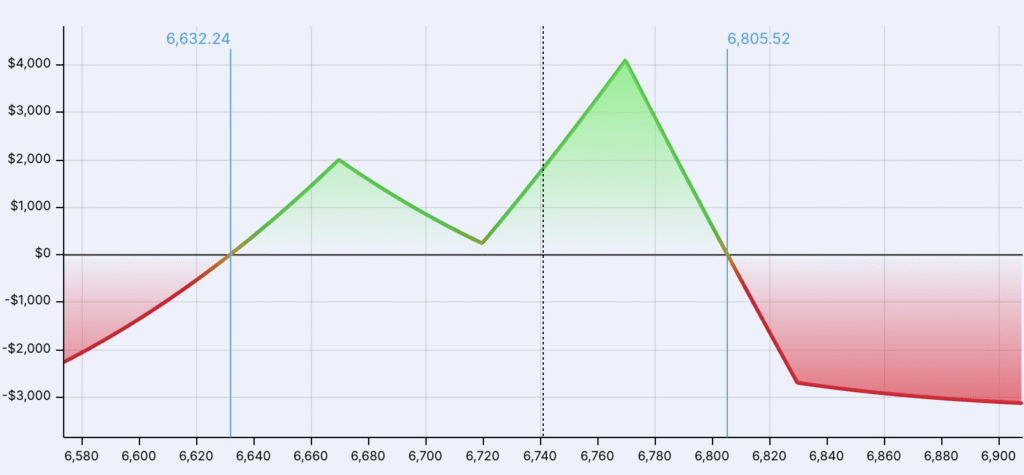Every options trader knows the fundamental trade-off: you can collect theta, but you expose yourself to vega. You can position for a volatility spike, but you’ll bleed premium when the market goes quiet. It’s a constant battle. So when a strategy claims to handle both rising and falling volatility while generating consistent income, skepticism is the only rational response.
But what if it actually worked?
Meet the Flyagonal (also known as the “Combo”) – a hybrid strategy popularized by Steve Ganz, who didn’t just backtest it, but traded it live, posting a stunning 96% win rate across dozens of SPX, ETF, and single-stock trades.
The Flyagonal fuses two familiar structures, the call broken-wing butterfly and the put diagonal spread, into a single, defined-risk position. By combining them, it neutralizes each leg’s weaknesses and creates a setup with wide profit zones and self-balancing Greeks that can thrive whether the market drifts higher, chops sideways, or volatility explodes.
If you’re already trading iron condors, calendars, or broken wings, the Flyagonal might be the most valuable addition to your playbook in years!
Anatomy of the Flyagonal
The first step to understanding the Flyagonal is recognizing its two core components. One is a call broken-wing butterfly, positioned slightly above spot, and built wide enough to capture upside drift and benefit from falling volatility. The other is a put diagonal, placed below spot, designed to expand in value when volatility spikes. Each has its own flaws, but together they cancel out many of each other’s weaknesses. Instead of relying on one direction, you’re building a trade that can handle a range.
Steve Ganz later introduced spin-offs like the Conagonal (condor + diagonal) and Vertagonal (vertical + diagonal), but the original fly + diagonal remains the foundation, and arguably, the most elegant form.

How It’s Constructed
Moving from concept to setup is straightforward but requires precision. Most live trades are opened with 8-10 days to expiry. The call broken-wing butterfly is placed about +40 points above spot, with wings 25-30 points wide. The put diagonal’s short strike sits roughly -40 points below spot, and its long leg is dated 16-20 days out. Typical entry debit ranges from $400-700 per SPX contract, or about one-tenth of that in SPY.
At entry, the position carries near-zero delta, strong positive theta, and a blend of short and long vega that largely neutralize each other. You pay a modest debit, define your risk, and create a structure that decays profitably day by day.
When to Enter
The Flyagonal is designed for low volatility environments. When IV rank is below 15, the long options in the diagonal are affordable, while the short options in the butterfly still carry enough premium to finance the trade. The sweet spot is 8-10 DTE for the shorts and 16-20 DTE for the longs, ideally when the calendar is clear of major events or earnings.
Most of Ganz’s live trades were executed in SPX, where liquidity and strike granularity allow for surgical precision. But the same logic extends to SPY, QQQ, IWM, and large-cap single names like Tesla, Nvidia, or Netflix. That cross-asset versatility matters, it shows the setup isn’t curve-fitted to a single underlying.
Trade Management and Exit Rules
The Flyagonal isn’t a set-and-forget trade. Its edge comes from disciplined management. The profit target is roughly 10% of risk capital, which in SPX terms means about $400-500 per trade. Average holding time: 4-5 days. Positions are typically closed 3-4 days before expiration to sidestep the gamma spike that builds in the final stretch.
Downside management is often self-correcting. When the market drops, volatility expands, the diagonal widens, and losses are cushioned. Upside is the real challenge, because a strong rally can compress the butterfly and leave the position exposed.
Common adjustments include:
- Rolling the short calls higher to restore balance.
- Closing the butterfly early while leaving the diagonal on.
- Hedging delta using Micro E-mini futures (MES) or short-dated calls.
Roughly half of all trades never required adjustments because profits were taken early. But during fast rallies, readiness to act often meant the difference between a smooth exit and a painful drawdown.
Example Trade
Imagine SPX at 6,700.
- Call side: buy 6,125C, sell 2× 6,150C, buy 6,180C
- Put side: sell 6,070P (8 DTE), buy 6,070P (16 DTE)
- Total debit: ≈ $400
At entry, the Greeks show delta ≈ 0, theta + 60/day, and modest mixed vega.
Day 1: flat.
Day 3: if SPX stays between 6,070-6,150, the position is typically up 7-10%. Many traders exit here, recycle capital, and look for the next setup. Others scale out, taking profits on part of the position and letting the rest run closer to expiration with reduced exposure.
Real Results
When traded live by Steve Ganz, the Flyagonal produced some of the most consistent short-term returns seen in an income-based options strategy. Across 60 live trades, 58 closed as winners – a 96.7% win rate. The average profit per trade was about $406, with total profits exceeding $24,000 over ten weeks. The average hold time was under five days, and most positions were closed for 7-10% gains before gamma could accelerate.
The largest recorded loss occurred during a sharp SPX rally and totaled just $600, confirming what the Greeks already imply; the main vulnerability isn’t a volatility spike, but a sustained upside trend that crushes implied volatility and compresses the butterfly.
Performance remained consistent across SPX, SPY, QQQ, RUT, and even single names like NVDA and TSLA, demonstrating that the setup wasn’t curve-fitted to one product or environment.
Where It Breaks
Models assume both expirations react evenly to volatility changes. Reality is harsher. In practice, near-term IV spikes faster and deeper, meaning the diagonal’s short leg can bleed quicker than the long leg can save you. In August 2024, a sudden 100-point SPX crash translated into a $4,500 loss. In January 2022, a slow 150-point grind lower sank both legs simultaneously. And on the upside, a sharp rally followed by a slow melt-up can steamroll the butterfly with little help from the diagonal.
Even the much-touted 96% win rate came during a friendly, low-volatility regime. My stress tests across different market environments show far lower consistency. Try to break the trade before you trust it. If it still holds up under your worst-case assumptions, then it deserves a place in your playbook.
Key Takeaways
The Flyagonal is one of the rare “new” strategies that truly earns its place in an advanced trader’s playbook. By blending a broken-wing butterfly with a put diagonal, it creates a structure that adapts across environments, defines risk upfront, and generates steady, repeatable returns in calm markets.
But it’s not a magic bullet. Fast crashes, persistent grind-downs, and runaway rallies will still hurt. The celebrated 96% win rate was achieved in favorable conditions, and my independent backtests reveal the same weak spots. Yet when deployed in the right regime (short duration, modest ranges, and low IV), it can serve as a reliable income engine with defined risk and clean mechanics.
For experienced traders already fluent in flies, calendars, and condors, the Flyagonal offers another path to collect theta while keeping vega balanced. Stress-test it. Size it small. Exit early. If it passes your own tests, it can become a powerful addition to your toolkit. And if it doesn’t, you’ll still gain what matters most: clarity about when it works, when it doesn’t, and why. That knowledge alone will make you a stronger investor.
